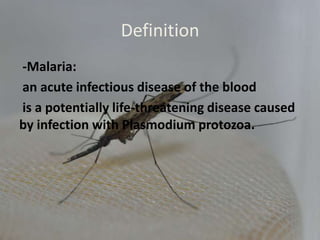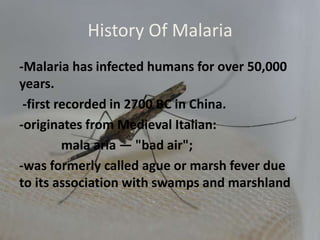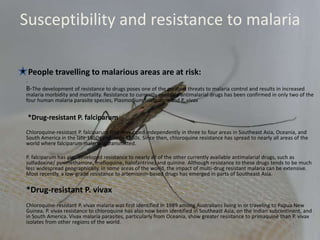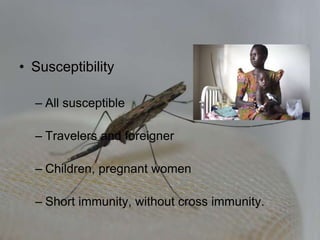Malaria is an acute, life-threatening infectious disease caused by Plasmodium protozoa, with its primary vector being the female Anopheles mosquito. It poses a significant health issue in Yemen, where P. falciparum is the most common strain, leading to approximately 700,000 annual cases. While malaria has been prevalent historically and remains a global concern, advancements in treatment and preventative measures have contributed to a decline in mortality rates in recent years.




![Life Cycle
The malaria parasite life cycle involves two hosts. During a blood meal, a malaria-
infected female Anopheles mosquito inoculates sporozoites into the human host .
Sporozoites infect liver cells and mature into schizonts , which rupture and
release merozoites . (Of note, in P. vivax and P. ovale a dormant stage
[hypnozoites] can persist in the liver and cause relapses by invading the
bloodstream weeks, or even years later.) After this initial replication in the liver
(exo-erythrocytic schizogony ), the parasites undergo asexual multiplication in the
erythrocytes (erythrocytic schizogony ). Merozoites infect red blood cells . The
ring stage trophozoites mature into schizonts, which rupture releasing merozoites
. Some parasites differentiate into sexual erythrocytic stages (gametocytes) .
Blood stage parasites are responsible for the clinical manifestationsof the
disease
The gametocytes, male (microgametocytes) and female (macrogametocytes), are
ingested by an Anopheles mosquito during a blood meal . The parasites’
multiplication in the mosquito is known as the sporogonic cycle . While in the
mosquito's stomach, the microgametes penetrate the macrogametes generating
zygotes . The zygotes in turn become motile and elongated (ookinetes) which
invade the midgut wall of the mosquito where they develop into oocysts . The
oocysts grow, rupture, and release sporozoites , which make their way to the
mosquito's salivary glands. Inoculation of the sporozoites into a new human host
perpetuates the malaria life cycle.](https://image.slidesharecdn.com/malariathebest-170220203855/85/Malaria-5-320.jpg)



































